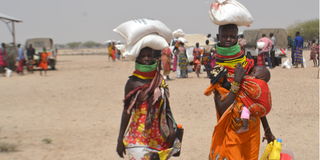Thousands face starvation and need aid, Turkana officials say

Turkana women walking home after receiving food donations.
Turkana County authorities have said thousands of people in all six constituencies need food aid.
Economic Planning Chief Officer Jeremiah Apalia on Thursday said 640,366 people face starvation, and 35 percent of animals are at risk of dying due to lack of water and pasture.
"There is a huge number of vulnerable children susceptible to high prevalence rates of acute malnutrition that exceeds the emergency threshold," Mr Apalia said.
The county, he said, was procuring relief food through the Directorate of Disaster Risk Management and was rolling out a contingency plan to protect livelihoods in pastoralism, fishing, agro-pastoralism and agriculture.
He appealed to well-wishers and humanitarian and development partners to prioritise supporting the health sector, the most strained.
He said county officials were working with the National Drought Management Authority (NDMA) to provide up-to-date information on drought so as to come up with an adequate and targeted response.
Among the interventions are the ongoing distribution of 3,846 bags of supplementary animal feeds and replenishing the eight-acre Natemito farm in Songot ward for use as rangeland.
The department of pastoral economy is also carrying out continuous livestock disease surveillance to inform vaccination and treatment activities.
The department of water, in partnership with other entities, is fixing broken boreholes and trucking water to selected villages.
Joseph Lotwel, an NDMA official, said the agency was developing a database that would help with drought mitigation and response.
Some of the well-wishers reaching out to the starving population are retired Bishop Silas Yego of African Inland Church, who donated relief food to 400 families in Turkana Central sub-county.
Mr Yego appealed to the government to invest in reliable and long-term solutions to food insecurity in arid and semi-arid areas like Turkana.
He said he had visited Israel, and Kenya could learn from it to produce more food.
"We can learn from such countries to completely solve food insecurity in northern Kenya as we will still continue experiencing longer and more intense droughts," he said.
The relief food he brought from his farm and with the support of friends, he noted, was not a reliable solution, as the starving population could not dictate who would distribute it, the quantities and for how long.





